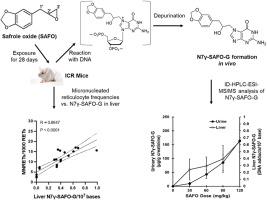Food and Chemical Toxicology ( IF 3.9 ) Pub Date : 2023-09-20 , DOI: 10.1016/j.fct.2023.114056 Kuen-Yuh Wu , Yu-Tzu Wei , Yu-Syuan Luo , Li-Chin Shen , Bao-Suei Chang , Ya-Yin Chen , Yan-Chi Huang , Hui-Fen Huang , Wen-Sheng Chung , Su-Yin Chiang

|
Safrole oxide (SAFO), a metabolite of naturally occurring hepatocarcinogen safrole, is implicated in causing DNA adduct formation. Our previous study first detected the most abundant SAFO-induced DNA adduct, N7-(3-benzo[1,3] dioxol-5-yl-2-hydroxypropyl)guanine (N7γ-SAFO-G), in mouse urine using a well-developed isotope-dilution high-performance liquid chromatography-electrospray ionization tandem mass spectrometry (ID-HPLC-ESI-MS/MS) method. This study further elucidated the genotoxic mode of action of SAFO in mice treated with SAFO 30, 60, 90, or 120 mg/kg for 28 days. The ID-HPLC-ESI-MS/MS method detected N7γ-SAFO-G with excellent sensitivity and specificity in mouse liver and urine of SAFO-treated mice. Our data provide the first direct evidence of SAFO-DNA adduct formation in rodent tissues. N7γ-SAFO-G levels in liver were significantly increased by SAFO 120 mg/kg compared with SAFO 30 mg/kg, suggesting rapid spontaneous or enzymatic depurination of N7γ-SAFO-G in tissue DNA. Urinary N7γ-SAFO-G exhibited a sublinear dose response. Moreover, the micronucleated peripheral reticulocyte frequencies increased dose-dependently and significantly correlated with N7γ-SAFO-G levels in liver (r = 0.8647; p < 0.0001) and urine (r = 0.846; p < 0.0001). Our study suggests that safrole-mediated genotoxicity may be caused partly by its metabolic activation to SAFO and that urinary N7γ-SAFO-G may serve as a chemically-specific cancer risk biomarker for safrole exposure.
中文翻译:

肝脏和尿液中 N7-(3-苯并[1,3]二氧醇-5-基-2-羟丙基)鸟嘌呤的剂量反应形成与施用黄樟素氧化物的小鼠的微核网织红细胞频率相关
氧化红黄藤素 (SAFO) 是天然存在的肝癌原黄风素的代谢产物,与导致 DNA 加合物形成有关。我们之前的研究首先使用完善的同位素稀释高效液相色谱-电喷雾电离串联质谱法 (ID-HPLC-ESI-MS/MS) 方法在小鼠尿液中检测到了最丰富的 SAFO 诱导的 DNA 加合物 N7-(3-苯并[1,3] 二氧醇-5-基-2-羟丙基)鸟嘌呤 (N7γ-SAFO-G)。本研究进一步阐明了 SAFO 在接受 SAFO 30、60、90 或 120 mg/kg 处理 28 天的小鼠中的遗传毒性作用模式。ID-HPLC-ESI-MS/MS 方法在 SAFO 处理小鼠的小鼠肝脏和尿液中检测到 N7γ-SAFO-G,具有出色的灵敏度和特异性。我们的数据提供了啮齿动物组织中 SAFO-DNA 加合物形成的第一个直接证据。与 SAFO 30 mg/kg 相比,SAFO 120 mg/kg 显着增加了肝脏中的 N7γ-SAFO-G 水平,表明组织 DNA 中 N7γ-SAFO-G 的快速自发或酶促脱嘌呤。尿 N7γ-SAFO-G 表现出亚线性剂量反应。此外,微核外周网织红细胞频率呈剂量依赖性增加,与肝脏 (r = 0.8647;p < 0.0001) 和尿液 (r = 0.846;p < 0.0001) 中的 N7γ-SAFO-G 水平显著相关。我们的研究表明,黄樟素介导的遗传毒性可能部分是由其对 SAFO 的代谢激活引起的,并且尿液 N7γ-SAFO-G 可能作为黄樟素暴露的化学特异性癌症风险生物标志物。






























 京公网安备 11010802027423号
京公网安备 11010802027423号